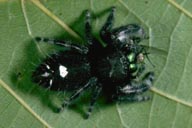| They possess 8 eyes and are known to have the sharpest vision of all spiders, important for hunting ability. The arrangement of the eyes, four big eyes on the face and four smaller eyes on top of the head, distinguished Saltids from other spiders.(3) The larger pair of eyes (anterior median on the face) apparently serve for sharp vision, and the others for peripheral vision. Since the lenses of these eyes are relatively fixed, the internal eye muscles serve to move the retina. Because the retina is the darkest part of the eye and it moves around, one can sometimes look into the eye of a jumping spider and see it changing color. When it is darkest, you are looking into its retina and the spider is looking straight at you.(4)
These spiders apparently have dichromic vision with spectral sensitivities in the green and ultraviolet range.(5) (Ultraviolet vision is apparently common in the insect and arachnid world.) They depend much upon their sense of sight to hunt or to court. It is apparently for this reason that many jumping spiders have iridescent markings or colors on their bodies, legs and chelicerae. In P. audax, the chelicerae are iridescent green.(6)
Jumping spiders are carnivores and predators. They eat insects and other spiders. These spiders do not spin webs but make little silken shelters under leaves or bark.(1)
Saltids are the most common biting spider in the United States.(7) Persons gardening appear to be at risk for disturbing the habitat of this spider which may react by jumping on exposed skin and inflicting a bite. The bite is usually asymptomatic to slightly painful and subsequently results in a local reaction such as an erythematous papule or a small urticarial wheal.
REFERENCES
1. Jumping Spiders (Family Salticidae) in Lorus and Margery Milne, The Audubon Society Field Guide to North American Insects
and Spiders. Alfred A. Knopf, New York, 1980. page 910
2. Richman David B. Status of Jumping Spider (Araneae Salticidae) Taxonomy worldwide. http://dns.ufsia.ac.be/Arachnology/Pages/Documents/Salticid.html
3. Saltids. http://spiders.arizona.edu/salticidae/salticidae.html
4. Wayne Maddison Jumping spider vision. http://spiders.arizona.edu/salticidae/ ++salticidae/anatomy/vision.html
5. De Voe RD. Ultraviolet and green receptors in principal eyes of jumping spiders. Journal of General Physiology, 1975 Aug,
66(2):193-207.
|
 Phidippus audax is the common jumping spider encountered in North America. So-called jumping spiders (Family Salticidae or Saltids) are known for the spectacular leaps the spiders make pouncing on their prey.(1) There are approximately 4000 members of this family worldwide, and they are especially numerous in the tropics.(2) All species are small, usually less than 15mm long. Jumping spiders do not construct webs, but actively hunt prey during the day, sneaking up and they pouncing on the victim. Many are brightly colored, sometimes with iridescent chelicerae (mouthparts).
Phidippus audax is the common jumping spider encountered in North America. So-called jumping spiders (Family Salticidae or Saltids) are known for the spectacular leaps the spiders make pouncing on their prey.(1) There are approximately 4000 members of this family worldwide, and they are especially numerous in the tropics.(2) All species are small, usually less than 15mm long. Jumping spiders do not construct webs, but actively hunt prey during the day, sneaking up and they pouncing on the victim. Many are brightly colored, sometimes with iridescent chelicerae (mouthparts).